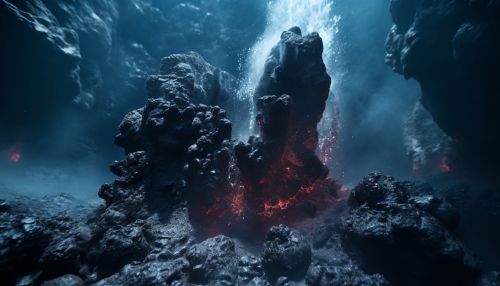Hydrothermal vents
Introduction
Hydrothermal vents are fissures located on the seafloor, particularly in areas with volcanic activity. These vents expel geothermally heated water, often rich in minerals and chemicals that can support unique ecosystems. The study of hydrothermal vents is a relatively recent field in oceanography, with the first vent system discovered in the late 20th century. The vents have been found in various locations across the world's oceans, including the Pacific Ocean's East Pacific Rise and the Atlantic Ocean's Mid-Atlantic Ridge.


Formation and Characteristics
Hydrothermal vents form due to the tectonic activity beneath the ocean floor. In areas where tectonic plates are diverging or converging, magma from the Earth's mantle can reach the seafloor, causing the water above to heat up and create a vent. The heated water is forced back out through the vent, carrying with it minerals and chemicals from the ocean crust and mantle.
The water expelled from hydrothermal vents can reach temperatures of up to 400 degrees Celsius. Despite the extreme heat, the water does not boil due to the high pressure at the depths where vents are found. This superheated water is typically rich in minerals such as iron, zinc, copper, and sulfur, which precipitate out of the water as it cools, forming chimneys around the vent.
Ecosystems
Hydrothermal vents support unique ecosystems that are unlike any other on Earth. These ecosystems are based on chemosynthesis, a process in which bacteria and archaea convert the chemicals expelled from the vents into energy. This energy is then used by other organisms in the vent ecosystem, including tube worms, clams, and various species of shrimp and crabs.
The organisms found at hydrothermal vents have adapted to survive in extreme conditions, including high temperatures, high pressure, and the presence of toxic chemicals. Many of these adaptations are not found in other marine environments, making vent ecosystems a subject of great interest to biologists and ecologists.
Exploration and Research
The exploration of hydrothermal vents has been a significant focus of oceanographic research since their discovery in the 1970s. This research has provided valuable insights into the geology of the ocean floor, the chemistry of the oceans, and the biology of deep-sea ecosystems.
Research on hydrothermal vents is conducted using a variety of methods, including remotely operated vehicles (ROVs), autonomous underwater vehicles (AUVs), and manned submersibles. These vehicles are equipped with cameras and scientific instruments to collect data and samples from the vent environment.
Economic and Environmental Significance
Hydrothermal vents have significant economic and environmental implications. The minerals precipitated from vent fluids are a potential source of valuable metals such as copper, zinc, and gold. However, the extraction of these minerals poses significant environmental challenges and risks, including potential damage to vent ecosystems and the release of toxic chemicals into the ocean.
From an environmental perspective, hydrothermal vents play a role in the global carbon cycle by providing a pathway for carbon dioxide to be removed from the ocean and sequestered in the ocean crust. Vents also contribute to the ocean's chemical balance by releasing minerals and nutrients into the water.
